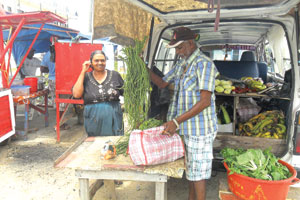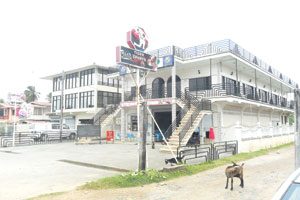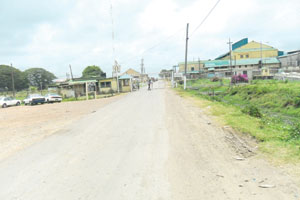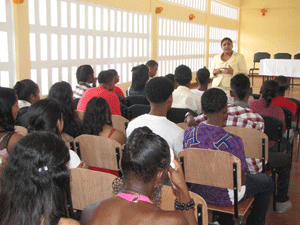I LOVE to feature in this column villages or communities which display a certain refreshing bond of ‘jovial harmony’ amongst ethnic bodies, and the very pleasurable spectacle of high ‘economic productivity’, made evident by the very businesslike bustle and hustle of its inhabitants.
 And we certainly did not have to travel very far, because the community of Enmore sits almost on the outskirts of Georgetown, beckoning with its sprawling stretches of houses and business entities, which certainly lent a distinct aura of economic boom that seems to be definitely escalating.
And we certainly did not have to travel very far, because the community of Enmore sits almost on the outskirts of Georgetown, beckoning with its sprawling stretches of houses and business entities, which certainly lent a distinct aura of economic boom that seems to be definitely escalating.
The community of Enmore sits along the coastal belt of Guyana, in Region 4, Demerara/Mahaica.
It is about two square miles (5.1 km2) in size, and has a multi-ethnic population of about 8,000, with large concentrations of Indo-Guyanese. Enmore is known for the Enmore Martyrs, who were slain during a 1948 labour dispute. The makings of the Enmore community dictate that it should absolutely be made into a township. It can be a town of great value, since it boasts of a history plus the many amenities and geo-political position many others don’t have.
The makings of the Enmore community dictate that it should absolutely be made into a township. It can be a town of great value, since it boasts of a history plus the many amenities and geo-political position many others don’t have.
People always flock to this community for shopping, using the post office, doing business, seeking jobs, attending school or places of worship, and so many other functions. Maybe we should start by opening a commercial bank at Enmore, because the people of Enmore have enjoyed coveted security for a long time.
Do you remember Roy Ferguson and Jug Singh? Or that literary maestros walked this land in the form of Peter Jailal and others. Selfless philanthropists like Manman, Sugrim Ramdular and others have patted the heads of the needy and sheltered the homeless. Religious gurus like Hyderalli, Father, the Bhawan family and others are known beyond the Enmore seawall! National cricketer, Sheik Mohamed and many other sports personalities are sons of this popular East Coast community. At present, ministers and lawyers from Enmore are known personalities who have something tangible for the next generation to venerate.
 Strong-willed and loving, so goes the epithet Enmore people have received gracefully.
Strong-willed and loving, so goes the epithet Enmore people have received gracefully.
History
Enmore was founded in the late 1940s when residents from a village to the southwest were granted plots of land there to start a new community. These plots were an upgrade from the primitive mud hut homes of the old village, which, bunched together, were unable to support the expanding population. The new area was better suited for cultivating fruits and vegetables, and proved reliable as the community grew.
In the 1950s, Enmore developed steadily, and within one decade of its founding, Enmore had more than doubled its population and had two primary schools and asphalt streets. Political strife between Indians and Africans in 1964 ground the Government and the economy to a standstill, causing commerce, schools and law enforcement to ceased functioning. A number of instances of murder, vandalism, looting, and civil disputes forced the diverse population of Enmore community to become segregated. Today, however, from all accounts, that issue has been sorted out, and both Africans and East Indians visibly get along quite well in almost every arena in the community.
Political strife between Indians and Africans in 1964 ground the Government and the economy to a standstill, causing commerce, schools and law enforcement to ceased functioning. A number of instances of murder, vandalism, looting, and civil disputes forced the diverse population of Enmore community to become segregated. Today, however, from all accounts, that issue has been sorted out, and both Africans and East Indians visibly get along quite well in almost every arena in the community.
After the riots of 1964, Enmore found itself with approximately 1,000 refugees from various neighbouring villages squatting on adjoining land. During this 1964/65 migration, Enmore satisfied the basic needs of the refugees but found itself taxed and impoverished by this provision.
A Community Centre was added in 1970 under the control of Bookers’ Sugar Estate, but control was yielded to community leaders soon afterwards, and today it is owned and operated by the community.
 In 1992, with the change in government and ruling political party, Guyana became a democratic state. Development in Enmore began again after twenty-eight years of stagnation. The population had continued to increase, and overpopulation was once again a problem. The new government started a programme to sell the land east and west of Enmore to its residents, bringing relief to the overcrowded community.
In 1992, with the change in government and ruling political party, Guyana became a democratic state. Development in Enmore began again after twenty-eight years of stagnation. The population had continued to increase, and overpopulation was once again a problem. The new government started a programme to sell the land east and west of Enmore to its residents, bringing relief to the overcrowded community.
Village culture
The culture in Enmore somewhat resembles that of the Indian immigrants who crossed the Atlantic Ocean over 150 years ago. Even though well over 90% of the population remains Indo-Guyanese, a small group of Chinese and Amerindian families are the minority. The culture is very similar to that of the rest of the British Caribbean, but according to the locals, it has an East Indian flair. In the beginning, the culture of Enmore greatly resembled that of the mother country, India, but as African and Chinese persons infiltrated the village, a slight variety was added. The residents of Enmore — the Indo-Guyanese, Afro-Guyanese and Chinese — brought their foods, traditions, religion and customs with them. But after the racially motivated outburst of 1964, Enmore became a 100% Indo-Guyanese village, but still the contributions the Afro-Guyanese and Chinese made had left lasting impressions in Enmore. This is very prevalent today in the food and language of the people.
In the beginning, the culture of Enmore greatly resembled that of the mother country, India, but as African and Chinese persons infiltrated the village, a slight variety was added. The residents of Enmore — the Indo-Guyanese, Afro-Guyanese and Chinese — brought their foods, traditions, religion and customs with them. But after the racially motivated outburst of 1964, Enmore became a 100% Indo-Guyanese village, but still the contributions the Afro-Guyanese and Chinese made had left lasting impressions in Enmore. This is very prevalent today in the food and language of the people.
Over the years, the Indian population of Enmore lost their mother tongue completely, and although Indian music remains very popular, the English language, with a slight Creole touch, has taken complete control. No one speaks Hindi anymore, and in Enmore it is considered a dead language. The colloquial English used is heavily influenced by the British. Being a colony for many years, Guyana is touched with a flair for things British in almost every activity, and so is Enmore. Like the British custom of drinking tea often, many of our daily activities are in small ways reflective of the past.
 The religious beliefs of the people have gone through a major transformation as well. Even though the composition of the population has remained the same for over 45 years, the religious beliefs have changed dramatically. The two dozen Christian churches that now dot the community claim over 60% of the younger generation and approximately 30% of the older generation have converted to this recently introduced faith. Regardless of religious conviction, every holiday, social or religious, is celebrated and respected. Many of the customs that are objective and foster public life are commonly organized by community leaders at home and abroad.
The religious beliefs of the people have gone through a major transformation as well. Even though the composition of the population has remained the same for over 45 years, the religious beliefs have changed dramatically. The two dozen Christian churches that now dot the community claim over 60% of the younger generation and approximately 30% of the older generation have converted to this recently introduced faith. Regardless of religious conviction, every holiday, social or religious, is celebrated and respected. Many of the customs that are objective and foster public life are commonly organized by community leaders at home and abroad.
Many of the original religious customs and traditions that have been retained have been modified by the ages and vestiges of an East Indian heritage, which appear in a number of the festivities. For example, few weddings are ever complete without the ceremonial rubbing of the dye; an old Indian wedding custom that is accepted among every religion. Holidays like Christmas and Diwali are examples of occasions when the entire community celebrates together in a congenial integration of faiths.
Our arrival As we arrived in Enmore, I almost doubled over with laughter as taxi drivers operating on the roadside tumbled over each other in their quest to be the first to pounce on the passengers getting off the East Coast mini-buses or other vehicles.
As we arrived in Enmore, I almost doubled over with laughter as taxi drivers operating on the roadside tumbled over each other in their quest to be the first to pounce on the passengers getting off the East Coast mini-buses or other vehicles.
And there was indeed quite a fuss created when they strove to see who would be the most fluent and well-mannered driver to be able to entice a journalist to have him use their car for the tour around the village.
We were told that Enmore is divided into North and South communities, so we decided to explore the North first. What was noted is that this location seemed not to house the stateliest buildings and businesses, but nevertheless showcased many classy houses that were pleasing to look at.
We were greeted by smiling women relaxing in their hammocks, some enjoying hot spicy lunches which they ate using their bare fingers. One very peppy grandmother, Silouchi Pertab, explained that she certainly enjoyed mashing her food around her plate before putting it into her mouth with her fingers. She claimed it was a traditional practice that was enjoyed by persons in every home in the village.
 “Bai, me does really enjoy me food with me fingas. Is suh we does eat since we ah lil gals; and trust me, you does really enjoy de food more. De food does taste moh sweet. When yuh done, yuh can lie down and relax bettah.”
“Bai, me does really enjoy me food with me fingas. Is suh we does eat since we ah lil gals; and trust me, you does really enjoy de food more. De food does taste moh sweet. When yuh done, yuh can lie down and relax bettah.”
We were certainly impressed with the paved access streets, but it was the fresh, pure East Coast breeze which really spiced up our visit. The crashing of the Atlantic waves against the nearby concrete seawall seemed to engulf one with a feeling of solace that made it difficult to leave the village after our mission had been completed.
The other side of the village actually produced a hub of activity, giving it the appearance of a commercial zone.
We were blown away with all the ‘hustle and bustle’ going on at the Shiva Woodworking Establishment, and workers were very busy at the Ghanadi & Sons Engineering entity. This area also housed the Enmore Poly Clinic, the Islamic Academy and many other productive agencies and entities. Persons were rushing in and out of the Super Deal Shopping Centre, filling their bags with household supplies. A few were busying themselves in the Laparkan Money Transfer outlet as they stuffed into their side bags with wide grins moneys sent to them by relatives overseas. And the Hall Meat Centre was certainly doing business, judging from the amount of women rushing in and out of its environs.
The village was enjoying its Phagwah festivities, as could be seen from the number of children all covered in abeer and powder.
At the roadside, many were rushing the food stall of Chef Ashton Clarke, who resides in Golden Grove Village but plies his trade in Enmore. And it was so pleasing to see both Indo and Afro individuals savouring the apparently delectable Creole dishes.
The ‘go-getter’ attitude
All around Enmore, there was a constant hustle and commercial bustle as villagers busied themselves with avenues of making a quick dollar or meeting their needs otherwise. There were certainly no limers in this community, and almost everyone seemed to be gainfully employed in some way or the other.
Many would have obtained temporary employment as the village prepared to construct a new housing scheme, made possible through government initiatives. A large number of villagers are also employed at the Enmore Sugar Factory, while some persons trade their produce at the Enmore Market Square.
Of course, several villagers are employed at stores, shops and schools in and outside the village. Others have taken up positions in schools and offices in the city as well.
To some extent too, the bread winners of many homes provide for their families through the cultivation and sale of rice and vegetables from their farms.
Community Centre Ground
This ground is still being used for concerts and local cricket matches; and some of the top Red Stripe cricket matches were played on this ground.
Sea defence
This community is protected from the Atlantic Ocean by the large concrete wall that runs along the entire coastal plain. The main pump station pumps water out whenever rain falls. The village that surrounds this sluice is called Logwood. There is also a cemetery in Enmore that allows families to properly bury their loved ones.
Schools
Enmore has two primary schools and three nursery schools; namely, the Enmore Hope Primary School, the Enmore Government School, the Newtown Nursery School, the Blossom Scheme Nursery School, and the Gandhi Nursery School.
Sugar factory
The Enmore Sugar Factory certainly lends a bustle of activity to the village, as cane harvesters, office workers, security guards, and mechanical and electrical workers move around looking serious and dedicated to their respective tasks. This factory has been in operation for over 75 years, and most of the residents of Enmore used to work at the factory at one time or another. However, over the years, the sugar workers began to take up office positions in the city. And according to reports from this location, the impressive Enmore Packaging Plant, housed in the factory compound, is working to expectations. The full capacity of the packaging plant is said to be 40,000 tonnes of packaged sugar per year.
Martyrs Monument
By 1948, most sugar workers in Guyana were giving support to the Guyana Industrial Workers Union (GIWU). On 22 April 1948, cane cutters, backed by the union, went on strike demanding the abolishment of the existing “cut and load” system in the fields. This reaping system, which forced cane cutters to load the punts with the canes they had cut, was not popular among cane cutters. It was introduced in 1945, and from time to time, workers had gone on strike to demand that it be changed. As part of the demands of the 1948 strike, the cane cutters called for the replacement of “cut and load” with a “cut and drop” system by which the cane cutters would cut the cane but other workers would load the punts for shipment to the factory.
In addition to this particular issue, the workers demanded higher wages and improved living conditions on the sugar estates. However, the real aim of the strike was to demand recognition of the GIWU, a forerunner of the GAWU, as the bargaining agent for the field and factory workers on all the sugar estates in the country.
The strike obtained political support from the Political Affairs Committee (PAC), and the workers were addressed at numerous public meetings by Dr. Cheddi Jagan, Mrs Janet Jagan, and leaders of the GIWU. The PAC bulletins were widely distributed at these meetings.
Dr. Jagan himself was personally involved in organising the strike, and helped to raise funds across the country to do it. Mrs Janet Jagan was also in the forefront of the struggle, operating soup kitchens for the striking workers and their families on the sugar estates.
As the strike continued, the recognized union, the MPCA, urged the workers to return to work, saying that their demand for higher pay would be taken up with the Sugar Producers Association (SPA). But the workers, who had no confidence in the MPCA, refused to heed this call, and stated that in any discussions with the SPA, they wanted only the GIWU to represent them. However, the SPA was adamant that negotiations would be conducted only with the MPCA, the recognized union.
With sugar production seriously affected by the ongoing strike, the sugar estates hired scab labour and enticed some workers to return to work. Retaliating, strikers went to the fields and chased those workers away, and in some cases physically attacked them.
On June 14, 1948, the SPA and the MPCA met to discuss the issues, but no satisfactory agreement was reached. In any case, the workers were not prepared to accept any agreement that the MPCA was negotiating, since they felt very strongly that the union was betraying their interests. On the following day, some strikers attacked the overseers and some strike-breakers at Non Pareil, and in the evening, there were reports of vandalism, including the cutting of telephone lines between Georgetown and Enmore.
Early on the morning of June 16, 1948, a crowd of about 400 workers gathered outside the factory at Enmore for a protest and picketing exercise. The management of Enmore Estate was expecting this protest action, and the evening before had requested assistance from the police. Lance Corporal James and six policemen, each armed with a rifle and six rounds of ammunition, had been sent from Georgetown early on the morning of June 16, and they reported to the management of Enmore Estate at 4.00 a.m. Two hours later, they took up positions in the factory compound, which was protected by a fence 15 feet high with rows of barbed wire running along the outward struts at the top.
By 10.00 a.m., the crowd had grown to between 500 and 600 persons, and was led by one of the workers carrying a red flag. The crowd attempted to enter the factory compound through the gates and two trench gaps at the rear by which punts entered the factory, but they were prevented from doing so because the locked gates and the punt gaps were protected by policemen. A section of the crowd then hurled bricks and sticks at the policemen, and several persons managed to enter the compound at the rear of the factory. The policemen tried to push back the crowd, but after this effort failed, they opened fire, killing five workers and injuring fourteen.
Lallabagee Kissoon, 30, was shot in the back; 19-year-old Pooran was shot in the leg and pelvis; Rambarran died from bullet wounds in his leg; Dookhie died in hospital later that day; and Harry died the following day from severe spinal injuries.
These men, through the years, became known as the Enmore Martyrs.
On June 17, the funeral of the slain men saw a massive crowd of people marching behind their coffins from Enmore to Le Repentir Cemetery in Georgetown, a distance of more than 16 miles.
This procession of thousands was led by Dr. Cheddi Jagan and PAC and GIWU leaders.
This tragedy and the ultimate sacrifice of those sugar workers greatly influenced Dr. Jagan’s political philosophy and outlook. At the graveside of the Enmore Martyrs, surrounded by thousands of mourners, Dr Jagan made a silent pledge that he would dedicate his entire life to the cause of the struggle of the Guyanese people against bondage and exploitation.
To investigate the shooting, the Governor, Sir Charles Wooley, appointed a commission of enquiry headed by Frederick Boland, a Supreme Court judge. The two other members of the commission were S. L. Van Batenburg Stafford and R. S. Persaud. Evidence was collected from some sixty-four persons and a report was presented in August 1948.
It is reported that in their testimony to the Commission, policemen involved in the shooting claimed that they were forced to shoot to protect the factory from destruction or damage, and to protect the lives of workers who were on the premises.
The police were widely criticised for not applying measures, such as the use to tear gas, to keep the crowd away from the factory compound.
One may want to dwell on the hectic past of this truly magnificent village, but let me point out that, despite its struggles, Enmore has been beautifully transformed into a location that is surely not only one of Guyana’s popular commercial zones, but should certainly be named Guyana’s next town.



.jpg)








